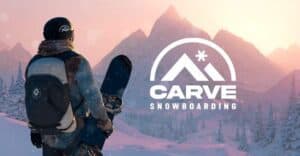I’ll confess, I don’t spend a lot of time on a snowboard. But Carve Snowboarding on the Oculus Quest is a fascinating game and well worth checking out. It may or may not be your winter sport, but there’s something to learn here in the game’s design. Snowboarding is a full-body experience, but right now, VR is largely an upper-body experience. It’s pretty much your headset and your controllers at play. Unless you’re in an advanced VR lab with trackers on your feet, your lower body doesn’t factor much into your immersive experiences.
Yet, Carve Snowboarding has actually come close to turning that upper-body immersive experience into one that makes you feel like your entire body is at play in this virtual environment.
Good design and good code can work wonders when done right.
Carve Snowboarding VR
VRScout unpacks how the game works:
Your professional snowboarding career begins in your cabin. This cozy location serves as your main base of operations in Carve Snowboarding. Here you can peruse through your collection of snowboards and mittens, customize your music playlist with a variety of indie tracks, listen to the radio, and play around with your snowball canon. You can even lower your blood pressure in between rounds by petting your virtual dog! It’s also here that you can select from a variety of courses to ride and game modes to compete in.
The cozy wooden cabin is a beautiful setting and includes a number of interactive elements – you can review your board and equipment options, pet a virtual dog, and create your own mixtapes on a retro cassette boombox for the slopes. But if there’s a weakness in the design, it’s that some of the objects remain frustratingly fixed in place.
My test for the realism of any VR experience these days is: What can I move? What can I break? If you’ve spent any amount of time in the real world (and you undoubtedly have if you’re reading this), you know it’s largely moveable and breakable. Half-Life: Alyx is our benchmark here – almost everything in the environment is a prompt for interaction.
Lesson for VR developers: if you put an object on a counter or shelf, let me pick it up, even if it has nothing to do with the specifics of the game. Same for a door – if it’s in the experience, I should be able to open it. It increases the sense of immersion which is critical for the larger context of the simulation.
Getting on the (Virtual) Slopes
Heading down the slopes is where Carve Snowboarding comes into its own in terms of immersive design. First, the quick video trailer.
Now let’s hit the slopes. As you head downhill, you get a first-person view, and you can grab your board to do tricks. Obstacles and rails abound, and it’s easy to execute jumps, spins and pick up speed. Like real-life snowboarding, it’s also easy to run into something. XR just dramatically lessens the consequences.
If there’s one element missing here, it’s that you should have tactile feedback in the controllers when you reach down and touch your virtual snowboard. That’s something that should be easy to add in a future update.
Other than that, Carve Snowboarding excels at creating a full-body experience. Real-life snowboarding depends on what you do with your legs and how you position your body. Carve Snowboarding deceives you into thinking what you do with your hand controllers actually involves your full body. You may look foolish to an external observer, but the virtual experience feels deeply realistic.
Some good code, and our brains are so easily fooled.
Again, VRScout,
Carve Snowboarding features unique VR locomotion mechanics that do a commendable job at replicating the sensation of riding a snowboard. Standing perpendicular to the slope, your boards’ movement is determined by the position of your arms. If you’re standing regular (left foot forward) for instance, moving your left arm back while swinging your right arm forward allows you to turn your board left, and vice-versa. To jump, all you need to do is lift both of your arms in the air; the higher you go, the bigger your air. This is how you perform tricks in Carve Snowboarding.
The immersive aspect benefits from the participation of Giles Goddard, who created the classic Nintendo 64 1080° Snowboarding. And it’s enough of a workout that the VR game belongs in the same category as Beat Saber, BoxVR, and Supernatural. Push yourself the first couple of times, and it will leave you panting for breath.
And for users who need or want to remain seated, there’s even an option for that – though we would strongly recommend removing any side tables and lamps near your chair.
Lessons from the Game

It takes a little time to master the controls of Cave Snowboarding, but it’s not overly difficult. And it’s worth trying out to see how an upper-body immersive experience can feel like you are using your entire body.
As Kyle Melnick concludes in VRScout,
Chuhai Labs and Goddard did a phenomenal job at redesigning the fundamental movements of snowboarding for use with motion controls, resulting in an incredibly satisfying action sports experience. Seriously, I could spend hours just mindlessly carving through virtual powder. In fact, that’s exactly what I’m going to do right now.
Simply put, it’s a lot of fun, even thrilling, as a VR experience. But even more, it shows the limitations of where we are in the trajectory of XR development and how you can creatively get around them. We’ve figured out how to nail down immersive visual experiences, but anything else on a consumer headset like the Oculus Quest requires tricking our mind into thinking the rest of our body is in play in the simulation. And this is exactly what Carve Snowboarding does so well.
Second note for VR developers: if you’re not deceiving us, you’re not doing your job.
Carve Snowboarding VR is now available on the Oculus Quest for $19.99. We’ll see you out on the (virtual) slopes.
Emory Craig is a writer, speaker, and consultant specializing in virtual reality (VR) and generative AI. With a rich background in art, new media, and higher education, he is a sought-after speaker at international conferences. Emory shares unique insights on innovation and collaborates with universities, nonprofits, businesses, and international organizations to develop transformative initiatives in XR, GenAI, and digital ethics. Passionate about harnessing the potential of cutting-edge technologies, he explores the ethical ramifications of blending the real with the virtual, sparking meaningful conversations about the future of human experience in an increasingly interconnected world.

